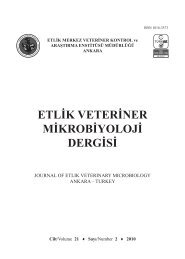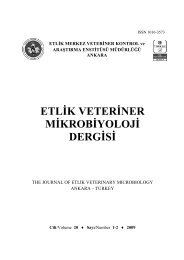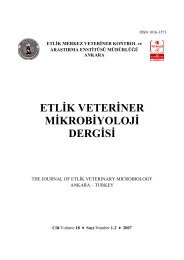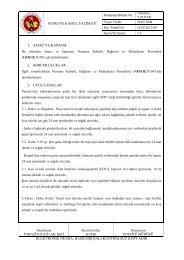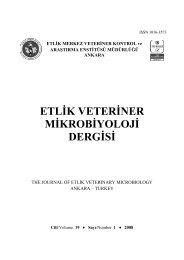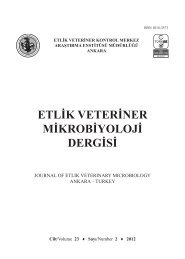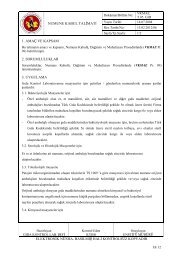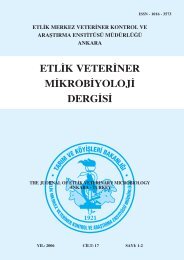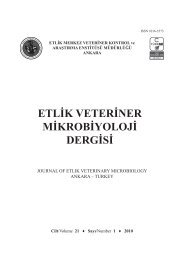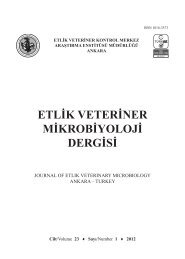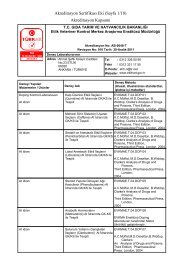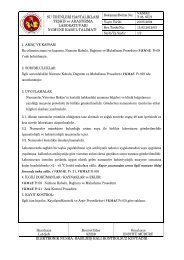etlik veteriner mikrobiyoloji dergisi - veteriner kontrol merkez ...
etlik veteriner mikrobiyoloji dergisi - veteriner kontrol merkez ...
etlik veteriner mikrobiyoloji dergisi - veteriner kontrol merkez ...
You also want an ePaper? Increase the reach of your titles
YUMPU automatically turns print PDFs into web optimized ePapers that Google loves.
VIII<br />
Journal of Etlik Veterinary Microbiology Publication Conditions<br />
1. The Journal is a refereed, scientific publication of Turkish Republic<br />
of the Ministry of Food, Agriculture and Livestock, Directorate<br />
of Etlik Veterinary Control Central Research Institute and is<br />
published two issues in a year. The abbreviation of the journal is “J<br />
Etlik Vet Microbiol”.<br />
2. In the Journal of Etlik Veterinary Microbiology, original research<br />
articles, actual reviews, case reports, short communications on the<br />
issue of veterinary medicine whose one part or whole have not been<br />
published in any other place before, and news from the institute<br />
are published. The review articles will be accepted only if they are<br />
original, actual and not repeating the classical knowledge. The author<br />
of the review is asked to possess original publications or researches<br />
on the subject at national or international levels.<br />
3. Manuscripts that will be prepared in Turkish and English should<br />
be typed as a full text, on A4 paper with 12 pt, in Times New Roman<br />
typing character, double-spaced and with 30 mm space in both<br />
sides of the paper. Manuscripts including figures and tables should<br />
not exceed 16 pages for original research articles, 10 pages for reviews,<br />
6 pages for case reports and 4 pages for short communications.<br />
4. Manuscript written in Microsoft Word format and figures in<br />
JPEG format at minimum 300 dpi resolution should be submitted<br />
to <strong>etlik</strong>vetmikrobiyolderg@gmail.com<br />
5. Original research articles and case reports should include in following<br />
rank: title, name(s) of the author(s), their addresses, abstract<br />
and key words in English, title, abstract and key words in Turkish,<br />
introduction, material and method, findings, discussion and conclusion,<br />
acknowledgements and references. In short communications<br />
and reviews, divisions except summaries should be omitted.<br />
6. Original research articles and case reports should be arranged<br />
and composed as in the following.<br />
Title should be brief, explanatory and written in small caps.<br />
Explanation(s) about the study should be written as footnotes.<br />
Author(s) should be mentioned by their names and surnames; their<br />
surnames should be written in capital letters and author(s) title<br />
should not be mentioned.<br />
Summary should be in Turkish and English, single paragraph and<br />
composed of at most about 500 words.<br />
Key Words should be written in alphabetical order and should not<br />
exceed 5 words.<br />
Introduction not exceeding two pages should include a short review<br />
of the literature related with the subject and in the end paragraph;<br />
the aim of the study should be mentioned.<br />
Material and Method should be written in an essential and comprehensible<br />
manner without getting into details. Subtopics should<br />
be mentioned first in bold and after in italic type.<br />
Findings should be shortly explained and data should not be repeated<br />
within the text. Legends should be indicated at the top of<br />
each table, whereas should be indicated at the bottom of each figure<br />
and print. Vertical lines are not allowed in tables.<br />
Discussion and Conclusion must include the evaluation and comparison<br />
of results with other researchers’ findings. The study’s<br />
contributions to the existing literature should also be explained<br />
briefly.<br />
Acknowledgements must be indicated before references if necessary.<br />
References should be listed alphabetically and chronologically by<br />
numbers. In the body of text, reference must be shown by author’s<br />
surname and list number or only by list number within parenthesis.<br />
If there is more than one reference that refers to the same issue,<br />
these should be arranged by smallest to biggest reference list<br />
numbers at the end of sentence. If the reference is more than two<br />
Yazarlara Bilgi / Instructions for Authors<br />
authors, the surname of the first author should be written and other<br />
authors should be mentioned with the abbreviation of “et al.”. For<br />
the abbreviation of journals, the latest edition of the “Periodical<br />
Title Abbreviations: By Abbreviation” should be taken as basis. If<br />
the author(s) have more than one publication within the same year,<br />
besides the publication date, it should be mentioned as “a” and “b”<br />
in the list of references.<br />
The writing of the references and their alignment should be as in<br />
the following examples.<br />
For articles:<br />
Dubey JP, Lindsay DS, Anderson ML, Davis SW, Shen SK,<br />
(1992). Induced transplacental transmission of N. caninum in cattle.<br />
J Am Vet Med Ass. 201 (5), 709-713.<br />
For books:<br />
Fleiss Jl, (1981). Statistical methods for rates and proportions.<br />
Second edition. New York: John Willey and Sons, p.103.<br />
For edited books:<br />
Balows A, Hausler WJ, Herramann Kl, eds., (1990). Manual of<br />
Clinical Microbiology. Fifth edition. Washington DC: IRL Press,<br />
p.37.<br />
For chapter in edited books:<br />
Bahk J, Marth EH, (1990). Listeriosis and Listeria monocytogenes.<br />
Cliver DD. eds. Foodborne Disease. Academic press Inc,<br />
San Diego. p.248-256.<br />
For congress papers:<br />
Çetindağ M, (1994). Pronoprymna ventricosa, a new digenic<br />
trematoda from the Alosa fallax in Turkey. Eighth International<br />
Congress of Parasitology (ICOPA VIII), October, 10-14, İzmir-<br />
Turkey.<br />
For dissertations:<br />
Aksoy E, (1997). Sığır Vebası hastalığının histolojik ve İmmunoperoksidaz<br />
yöntemle tanısı üzerine çalışmalar. PhD Thesis, Ankara<br />
University Institute of Health Sciences, Ankara.<br />
Corresponding address, in multiple-author studies, as a correspondence<br />
address, only one of the authors’ name/surname, address<br />
and e-mail should be mentioned at the end.<br />
7. Genus and species names in Latin should be written in italic. All<br />
measures should be given according to the SI (Systeme Internationale)<br />
units.<br />
8. The articles that are sent to be published in the journal should be<br />
sent with a covering letter and “Publication Rights Transfer Agreement”<br />
signed by all of the authors. The selected articles for the<br />
publication, and if asked for, the decision of the editorial committee<br />
concerning the publication, are declared to the article’s author/<br />
authors.<br />
9. The wording of “Ethical Commission Permission is obtained”<br />
should appear in scientific studies based on animal experiments,<br />
which will be published in the Journal of Etlik Veterinary Microbiology.<br />
10. As the edition of the sent articles are done in accordance with<br />
the original text, all responsibility of the articles bear on the authors.<br />
11. Researches that aim at comparisons of the products with their<br />
commercial names are out of the journal’s theme scope.<br />
12. The trade marks of materials and products that are subject of the<br />
research should not be mentioned.<br />
13. If the research is supported by a foundation, name of the foundation<br />
and project number must be mentioned.<br />
14. The articles that are sent to the journal are published in line with<br />
their coming date.<br />
15. Unpublished papers are not returned to their author.



